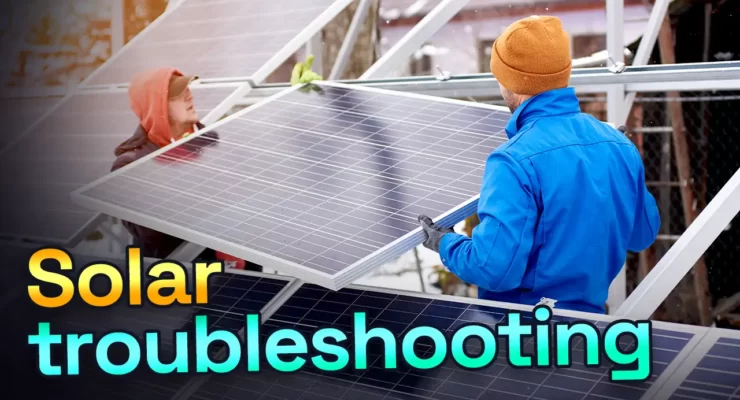Fast read
Investing in solar energy offers numerous benefits, but occasional issues can impact system performance. To ensure your solar investment remains efficient, it's essential to diagnose and address problems promptly. This guide covers key steps to identify issues with your newly installed solar system.
Understanding Solar System Performance: Solar panels convert sunlight into electricity, with inverters converting it for household use.
Monitoring Your Solar Inverter: Check indicator lights for any errors, and consult online monitoring tools for real-time data.
Inspecting Solar Panel Cleanliness: Regularly clean panels to remove dirt and debris that can reduce efficiency.
Troubleshooting Shading Issues: Address shading from nearby objects that obstruct sunlight.
Seeking Professional Assistance: Contact solar technicians for complex issues, ensuring your system operates optimally.
By staying proactive and vigilant, you can maximise the benefits of your solar investment for years to come.
How to Diagnose Problems with Your Newly Installed Solar System
With the increasing popularity of solar energy, more homeowners are investing in rooftop solar panels to reduce their electricity bills and carbon footprint. However, despite the numerous benefits of solar power, occasional issues may arise, impacting the system’s performance and efficiency. Diagnosing these problems early is crucial to ensure your solar investment continues to deliver maximum benefits. This comprehensive guide will explore various methods to identify and address common issues with your newly installed solar system.
Understanding Solar System Performance
Before delving into diagnostic methods, it’s essential to understand how solar systems operate and what factors can affect their performance. Solar photovoltaic (PV) systems generate electricity by converting sunlight into usable energy through solar panels installed on your roof. An inverter then converts this direct (DC) electricity into alternating (AC) electricity, which powers your home or is exported to the grid.
Monitoring Your Solar Inverter
One of the first steps in diagnosing solar system issues is to inspect your solar inverter. The inverter serves as the “brain” of your solar system, monitoring its performance and converting DC electricity to AC electricity. During daylight hours, observe the indicator lights on your inverter. A solid green light indicates regular operation, while flashing red or orange lights may indicate a fault or error code. If you cannot access online monitoring, check the inverter’s display screen for error messages or consult the user manual for troubleshooting tips.
Utilising Online Monitoring Tools
Many modern solar systems come equipped with online monitoring tools that provide real-time data on system performance. Accessing your online monitoring account lets you view detailed statistics and graphs showing your system’s energy production over time. Compare these figures to your system’s expected performance to identify discrepancies or irregularities. Online monitoring tools also allow you to track daily, monthly, and annual energy production, enabling you to detect any sudden drops or fluctuations in output.

Inspecting Solar Panel Cleanliness
Dirt, dust, and debris can accumulate on solar panels over time, reducing their efficiency and output. Periodic visual inspections of your solar panels can help identify any buildup or obstructions affecting performance. If your panels appear dirty or obscured, consider cleaning them using a gentle hose or professional cleaning service. Additionally, check for any shading caused by nearby trees, buildings, or obstructions, as shade can significantly impact solar panel performance.
Troubleshooting Shading Issues
Shading is a common problem affecting solar panel performance, particularly in densely populated areas or regions with tall buildings or trees. Even partial shading on one panel can affect the overall output of your entire solar array. To mitigate shading issues, consider installing microinverters or power optimisers, which optimise individual panels’ performance and minimise shading’s impact. Alternatively, trim back overhanging branches or obstructions for maximum sunlight exposure.
Seeking Professional Assistance
If you cannot diagnose or resolve issues with your solar system independently, don’t hesitate to seek professional assistance. Qualified solar technicians have the expertise and tools to identify and address complex issues with your system, ensuring optimal performance and efficiency. Schedule regular maintenance checks and inspections to catch any potential problems early and prolong the lifespan of your solar investment.
In conclusion, diagnosing problems with your newly installed solar system requires a combination of visual inspections, monitoring tools, and professional expertise. By staying vigilant and proactive, you can ensure that your solar investment continues to deliver clean, renewable energy for years to come. Remember to document any issues or abnormalities and contact your solar installer or technician for assistance when needed. With proper maintenance and care, your solar system will remain a reliable and efficient source of clean energy for your home.
